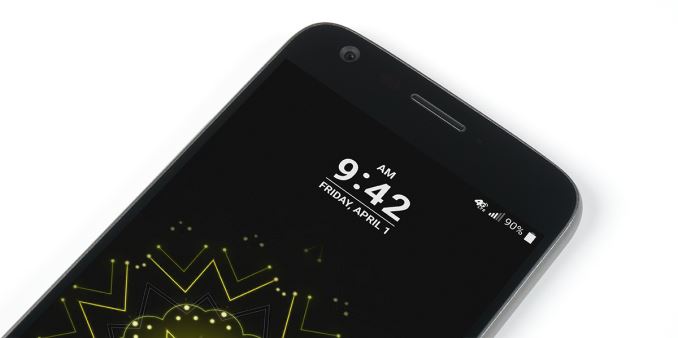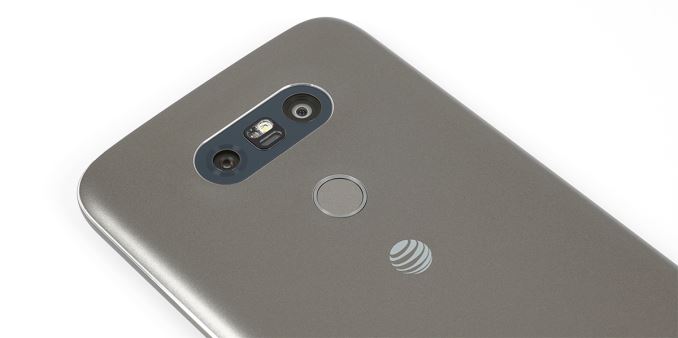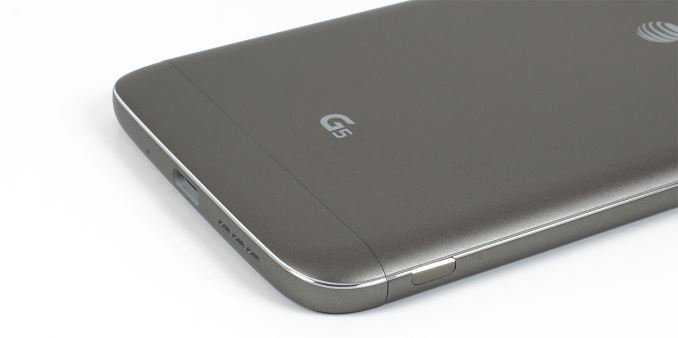The LG G5 Review
by Matt Humrick on May 26, 2016 8:00 AM EST- Posted in
- Smartphones
- Snapdragon
- Qualcomm
- LG
- Mobile
- Snapdragon 820
- LG G5
Final Words
With so many smartphones to choose from, it’s difficult for any one device to stand out. This is especially true for flagships that come packed with the best hardware and nearly every feature available. The implementation of these features and how they contribute to a positive user experience—a bright screen with accurate colors, a fingerprint reader that’s fast and accurate, a high resolution camera that actually takes good pictures, software enhancements that improve usability and customizability without adding bloat—was a differentiator in the past, but I would argue that with the smartphone market maturing and the price modern flagships sell for, there’s little room for compromise here either.
The G5 comes with an impressive list of hardware, but combining a removable battery with an aluminum unibody design is the G5’s big innovation and highlight feature. LG’s mechanism works well, with two minor exceptions: The chin section requires some work before it pulls free and the plastic battery retention scheme raises some concern about durability.
The modularity this design affords is a bonus, but we’re not sure this idea will catch on. Currently there’s only two modules available: the LG CAM Plus, which is a hand grip that adds physical buttons for some camera controls and comes with its own larger battery, and the LG Hi-Fi Plus with B&O PLAY, which adds a Hi-Fi DAC for audio playback (not available in the U.S.). There is an HDK and SDK, which opens the door for third-party modules in the future, but the G5 will need to sell in sufficient quantities to make it worthwhile for companies to develop them. Also, the design of any future LG phones will need to be dimensionally compatible with the G5 or the current modules will no longer work. Maintaining this design constraint for more than a couple generations seems impractical.
The G5’s design and materials are a big departure from previous G Series phones. While the appeal of its new appearance is open for debate, we can definitively say that its ergonomics are excellent. The rounded corners and curved back edges eliminate pain points when holding the phone, and the polished step where the back meets the sides provides enough purchase to keep the phone from feeling slippery. The front is covered by LG’s 3D Arc Glass, which adds a large radius along the top edge where the speaker is located. This too serves an ergonomic purpose: It helps the phone lay more naturally against your ear and eliminates another sharp edge.
With a Snapdragon 820 SoC, 4GB of LPDDR4 RAM, and UFS 2.0 storage, the G5 uses much of the same internal hardware as other flagship phones of its generation. It’s no surprise then that it delivers excellent performance. While the Kirin 950 and 955 SoCs in Huawei’s Mate 8 and P9, respectively, perform better than the G5’s Snapdragon 820 in our system tests, and the G5 is a tick slower than its peers in our web tests, its Adreno 530 GPU is a top performer and the phone feels plenty fast in general.
There are several implementation issues that negatively impact the G5’s user experience, however, starting with the display’s lack of calibration. It’s exceedingly cold white point gives the screen a noticeable blue tint and grayscale and sRGB color accuracy are poor. The G5’s LCD display is capable of reaching an impressive 800 nits brightness using LG’s Daylight Mode feature with auto-brightness enabled, but this is only temporary. Over a period of two minutes, the display gradually dims until it hits a stable value of 405 nits. Peak brightness is even worse in manual mode: After reaching a peak value of 405 nits, the backlight drops to a stable value of only 334 nits after 45 seconds. LG is a leading supplier of LCDs for mobile devices, and its flagship phones should serve as a showcase for its technology. Sadly, this is not the case for the G5.
Besides the removable battery, the G5’s other semi-unique feature is its dual rear camera. While there are certainly uses for the second wide-angle camera, we feel that the image distortion that results from using a fisheye lens will severely limit how often it’s used. Using the two cameras together could potentially boost image quality for every picture taken and would be a better use of resources, rather than letting one of the cameras always sit idle.
The G5’s rear cameras do take excellent photos in bright light, equaling the Galaxy S7’s image quality, but fall short of expectations in lower-light conditions. The G5 still does well handling white balance and exposure; however, its images show a significant amount of noise that noticeably degrades quality. LG also has not significantly updated the G Series’ video recording capabilities in two years, which puts the G5 on par with current mid-range phones today.
Just below the dual rear camera module is another new feature for the G5: a combination fingerprint reader and power button. While it’s located in a convenient spot, its accuracy is very poor. I have not had this much trouble with a fingerprint sensor since the Galaxy S5. Even when the sensor works it takes multiple attempts. Having to punch in my pin code after five failed attempts was a regular occurrence. I had a similar experience with two different G5’s, so this issue is not because of a single faulty unit.
Ultimately, the G5, like the G4, ends up feeling like an upper mid-range phone rather than a true flagship. It does have a nice array of features, including a removable battery—a true rarity these days—and microSD support, along with excellent performance, but many of its features are poorly executed. If the G5’s price falls to $500 USD or less like it did with the G4, it would be easy to recommend, especially if you need the removable battery. At its launch price, however, it seems overpriced relative to the competition.














92 Comments
View All Comments
SirGCal - Thursday, May 26, 2016 - link
I have a release G5 and I do not have any issues with backlight bleed. Too many of the issues listed in reviews are pre-release demo reviews but I also notice that some issues exist between brand models. Sprint vs the others, etc. Dunno why that would matter.kspirit - Thursday, May 26, 2016 - link
Mess.Shadowmaster625 - Thursday, May 26, 2016 - link
There needs to be a very small internal battery to allow you to swap batteries without rebooting. At any rate its nice that the consumer is at least getting a chance to vote on how important these features are to them.Lolimaster - Friday, May 27, 2016 - link
I thought the same, a small soldered battery should make the modularity awesome.The screen is complete cr@p, and LG owns IPS, how can they fail so hard, 3 TIMES IN A ROW.
hans_ober - Thursday, May 26, 2016 - link
Nice review! :)The display section was really nice to read. I don't mind waiting for AT reviews because of the content, but try and get these done quicker. Many of us want to buy devices as soon as they're released, but we end up waiting for your review.
Cakefish - Thursday, May 26, 2016 - link
Is S7 part 2 ever happening? Both the iPhone SE and the LG G5 came out after the Galaxy S7. At this rate I'm expecting HTC 10 review before S7. Poor chap who's writing the article must be real busy. Guess I'd rather it be the usual Anandtech level of quality than rushed with no substance. This isn't meant to be a complaint, I love the content this website produces.Anyway, this review is fantastic, as always.
smartthanyou - Thursday, May 26, 2016 - link
Does LG supply monthly OS updates? Of course they don't.But before you complain about the carriers blocking such updates I will point out the simple fact that if OEMs started actually delivering updates to the cellular carriers every month there would be a huge amount of pressure on the cell companies to change how they handle software updates.
But OEMs don't provide updates and not because of the carriers, because they don't work to do the work to provide them.
Sorry, the only phones people should be considering at this time are Nexus phones and iPhones. All others are a compromise not worth making.
anactoraaron - Thursday, May 26, 2016 - link
I have an s7e on T-mo and I believe I've had 4 updates in the 2 months I've had it. All but the fm radio being enabled were security updates. I actually got the May 1 security patch via OTA on the 4th.I believe Samsung will be better with updates (particularly with security updates) due to Samsung Pay.
Normally I'd agree with you, but if Samsung keeps up what they are doing so far with the s7 amd s7e then this may not be true anymore.
arayoflight - Thursday, May 26, 2016 - link
They have been doing this since the s6. I have s6 and got the may patch on 10th.Ariknowsbest - Thursday, May 26, 2016 - link
My S5 (s801 EU) last security update is from Nov 2015. Was interested in the S7 but I rather stay away.They simply have too many models and variants.